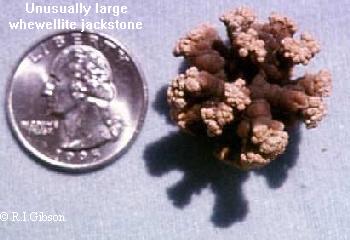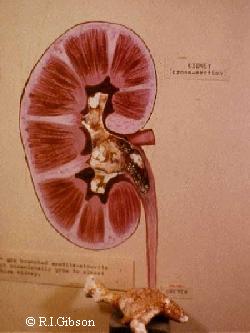Dick Gibson's first career was as an analyst of kidney stones and other biological mineral concretions. He examined more than 20,000 of them in 4 years.
Herewith is a list of common minerals found in stones.
APATITE
 APATITE is a common mineral in nature. Chemically it is a complex calcium phosphate with attached molecules of hydroxyl (OH), fluorine (F), and sometimes, other elements. Apatite is the fundamental mineral component in bones and teeth, and when apatite has fluorine in its crystal structure, it is stronger. This is why fluorine is added to water and toothpaste. In kidney stones, carbonate (CO3) substitutes for some of the phosphate, making a mineral that is relatively poorly crystallized. Its formula in kidney stones is usually given as Ca5(PO4,CO3)3(F, OH, Cl). Well-crystallized or not, apatite often forms the nucleus upon which other urinary minerals are deposited. It usually occurs as a white powdery mineral deposit. Mineral Name Index
APATITE is a common mineral in nature. Chemically it is a complex calcium phosphate with attached molecules of hydroxyl (OH), fluorine (F), and sometimes, other elements. Apatite is the fundamental mineral component in bones and teeth, and when apatite has fluorine in its crystal structure, it is stronger. This is why fluorine is added to water and toothpaste. In kidney stones, carbonate (CO3) substitutes for some of the phosphate, making a mineral that is relatively poorly crystallized. Its formula in kidney stones is usually given as Ca5(PO4,CO3)3(F, OH, Cl). Well-crystallized or not, apatite often forms the nucleus upon which other urinary minerals are deposited. It usually occurs as a white powdery mineral deposit. Mineral Name Index
WHEWELLITE

 WHEWELLITE is a calcium oxalate (CaC2O4.H2O) that is extremely rare in nature. It is known to occur in septarian nodules from marine shale near Havre, Montana, with golden calcite at Custer, South Dakota, and as a fault filling with celestite near Moab, Utah. It is found in hydrothermal veins with calcite and silver in Europe, and it often occurs in association with carbonaceous materials like coal, particularly in Saxony, [former] Czechoslovakia, and Alsace. It is one of the most common kidney stone minerals, however, where it typically occurs as small, smooth, botryoidal to globular yellow-green to brown, radially fibrous crystals. Whewellite stones larger than ½ inch across are quite unusual. Often whewellite is deposited upon a tiny nucleus of apatite, which may form as build-ups on the tips of tiny papillae in the kidney.
WHEWELLITE is a calcium oxalate (CaC2O4.H2O) that is extremely rare in nature. It is known to occur in septarian nodules from marine shale near Havre, Montana, with golden calcite at Custer, South Dakota, and as a fault filling with celestite near Moab, Utah. It is found in hydrothermal veins with calcite and silver in Europe, and it often occurs in association with carbonaceous materials like coal, particularly in Saxony, [former] Czechoslovakia, and Alsace. It is one of the most common kidney stone minerals, however, where it typically occurs as small, smooth, botryoidal to globular yellow-green to brown, radially fibrous crystals. Whewellite stones larger than ½ inch across are quite unusual. Often whewellite is deposited upon a tiny nucleus of apatite, which may form as build-ups on the tips of tiny papillae in the kidney.
Mineral Name Index
WEDDELLITE

 WEDDELLITE, CaC2O4.2H2O, was named for occurrences of millimeter-sized crystals found in bottom sediments of the Weddell Sea, off Antarctica. Unfortunately the sharp yellow crystals that urinary weddellite forms are often much larger than that, and they are frequently the cause of the pain experienced in passing a kidney stone. Rarely, weddellite crystals may occur that are neary a half inch on an edge, but most are somewhat smaller. The yellow crystals are commonly deposited upon the outer surface of a smooth whewellite stone. Like whewellite, weddellite is a calcium oxalate. They differ in the amount of water that is included in their crystal structures, and this gives them very different crystal habits. Occasionally, weddellite partially dehydrates to whewellite, forming excellent pseudomorphs of grainy whewellite after weddellite's short tetragonal dipyramids. Together, apatite, whewellite, and weddellite are probably the most common urinary stones.
WEDDELLITE, CaC2O4.2H2O, was named for occurrences of millimeter-sized crystals found in bottom sediments of the Weddell Sea, off Antarctica. Unfortunately the sharp yellow crystals that urinary weddellite forms are often much larger than that, and they are frequently the cause of the pain experienced in passing a kidney stone. Rarely, weddellite crystals may occur that are neary a half inch on an edge, but most are somewhat smaller. The yellow crystals are commonly deposited upon the outer surface of a smooth whewellite stone. Like whewellite, weddellite is a calcium oxalate. They differ in the amount of water that is included in their crystal structures, and this gives them very different crystal habits. Occasionally, weddellite partially dehydrates to whewellite, forming excellent pseudomorphs of grainy whewellite after weddellite's short tetragonal dipyramids. Together, apatite, whewellite, and weddellite are probably the most common urinary stones.
Mineral Name Index
STRUVITE

 STRUVITE is a magnesium ammonium phosphate, Mg(NH4)(PO4).6H2O, that forms distinctive coffin-shaped crystals. Often masses of tiny crystals grow together with powdery apatite to form huge branching stones called "staghorns," which may be several inches long. They may even fill up the entire open area of a kidney. Struvite stones are sometimes associated with bacterial infections of the urinary system. They also require non-acid systems to form, as indicated by the presence of ammonium (a basic, non-acidic compound) in the crystalline structure. The only common occurrence of struvite outside the urinary system is in bat guano. Certain dogs (especially dalmatians) can produce remarkable large, smooth, milky-white tetrahedrons of well-crystallized struvite.
STRUVITE is a magnesium ammonium phosphate, Mg(NH4)(PO4).6H2O, that forms distinctive coffin-shaped crystals. Often masses of tiny crystals grow together with powdery apatite to form huge branching stones called "staghorns," which may be several inches long. They may even fill up the entire open area of a kidney. Struvite stones are sometimes associated with bacterial infections of the urinary system. They also require non-acid systems to form, as indicated by the presence of ammonium (a basic, non-acidic compound) in the crystalline structure. The only common occurrence of struvite outside the urinary system is in bat guano. Certain dogs (especially dalmatians) can produce remarkable large, smooth, milky-white tetrahedrons of well-crystallized struvite.
Mineral Name Index